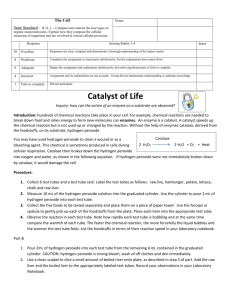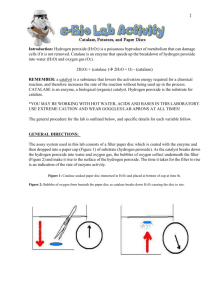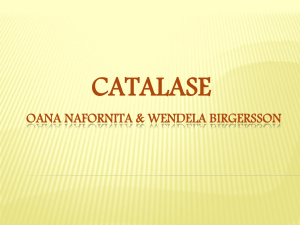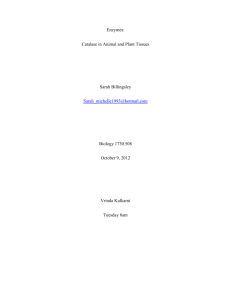Investigating The Affect Of Peroxide Concentration On Oxygen
advertisement
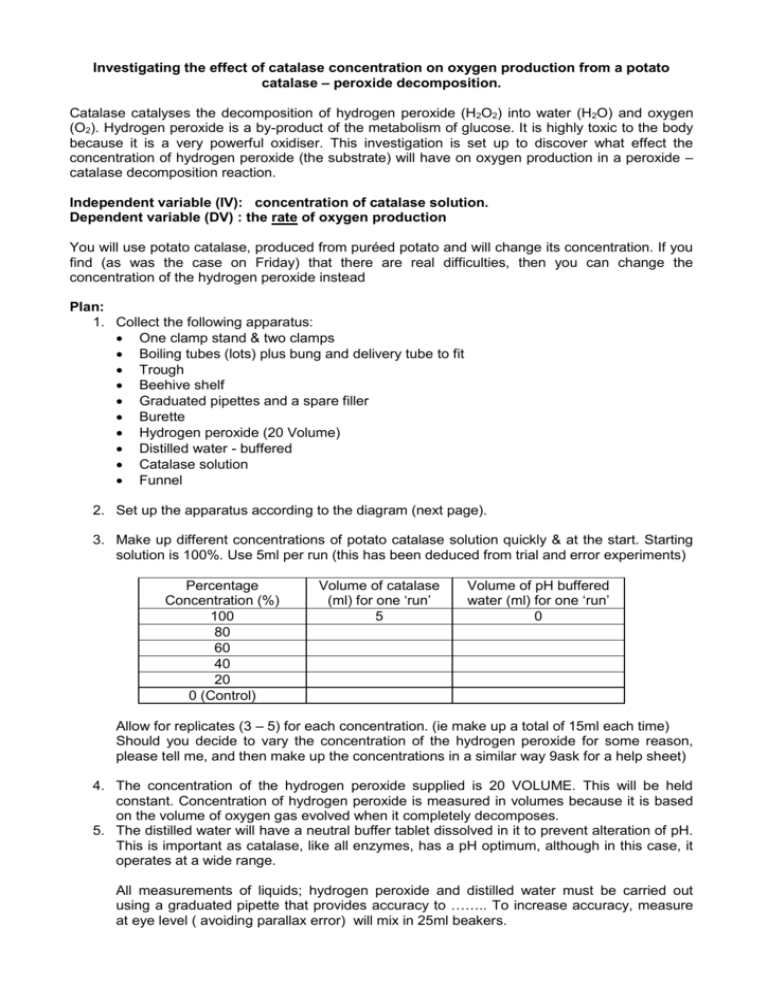
Investigating the effect of catalase concentration on oxygen production from a potato catalase – peroxide decomposition. Catalase catalyses the decomposition of hydrogen peroxide (H2O2) into water (H2O) and oxygen (O2). Hydrogen peroxide is a by-product of the metabolism of glucose. It is highly toxic to the body because it is a very powerful oxidiser. This investigation is set up to discover what effect the concentration of hydrogen peroxide (the substrate) will have on oxygen production in a peroxide – catalase decomposition reaction. Independent variable (IV): concentration of catalase solution. Dependent variable (DV) : the rate of oxygen production You will use potato catalase, produced from puréed potato and will change its concentration. If you find (as was the case on Friday) that there are real difficulties, then you can change the concentration of the hydrogen peroxide instead Plan: 1. Collect the following apparatus: One clamp stand & two clamps Boiling tubes (lots) plus bung and delivery tube to fit Trough Beehive shelf Graduated pipettes and a spare filler Burette Hydrogen peroxide (20 Volume) Distilled water - buffered Catalase solution Funnel 2. Set up the apparatus according to the diagram (next page). 3. Make up different concentrations of potato catalase solution quickly & at the start. Starting solution is 100%. Use 5ml per run (this has been deduced from trial and error experiments) Percentage Concentration (%) 100 80 60 40 20 0 (Control) Volume of catalase (ml) for one ‘run’ 5 Volume of pH buffered water (ml) for one ‘run’ 0 Allow for replicates (3 – 5) for each concentration. (ie make up a total of 15ml each time) Should you decide to vary the concentration of the hydrogen peroxide for some reason, please tell me, and then make up the concentrations in a similar way 9ask for a help sheet) 4. The concentration of the hydrogen peroxide supplied is 20 VOLUME. This will be held constant. Concentration of hydrogen peroxide is measured in volumes because it is based on the volume of oxygen gas evolved when it completely decomposes. 5. The distilled water will have a neutral buffer tablet dissolved in it to prevent alteration of pH. This is important as catalase, like all enzymes, has a pH optimum, although in this case, it operates at a wide range. All measurements of liquids; hydrogen peroxide and distilled water must be carried out using a graduated pipette that provides accuracy to …….. To increase accuracy, measure at eye level ( avoiding parallax error) will mix in 25ml beakers. 6. Fill a burette with water using a second graduated pipette filler. (Placing it over the neck of the upturned burette, opening the tap ensuring there is a good seal and that the other end is under water, and drawing the water up the burette – see diagram.) 7. Add the measured volume of the appropriate concentration of catalase solution to a boiling tube & place the end of the delivery tube under the funnel which is itself under the burette. 8. After adding ml of peroxide (measured with a graduated pipette) to the catalase in the boiling tube, immediately (error here!) add the bung & start timing the volume of oxygen evolved for precisely 1 minute. Every ten seconds, record the volume of oxygen in the burette. (Ideally the bung would be inserted first and then the yeast suspension would be injected through a hypodermic syringe) 9. The burette must be refilled using the same method as before. Using a fresh boiling tube, catalase solution and peroxide. Repeat the experiment for the chosen concentration, obtaining at least three, and possibly five sets of results for one concentration. This, together with the measures you have put in place to ensure precision, should give reliable results. Use sense here: if you work with a partner, or in a three, that’s fine, but make sure everyone has identical apparatus and that you work more or less simultaneously (H2O2 decomposes, even without an enzyme or catalyst and this could definitely cause error) 10. Change the concentration of catalase in accordance with the plan overleaf and continue the experiment until there are five repeats for each concentration 11. Record on a rough chart but enter results on a spreadsheet so you can calculate the average rate of reaction (oxygen evolution) for each concentration from the data obtained. You could record direct onto a spreadsheet if you use a laptop Draw your own apparatus if you need to. http://www.ase.org.uk/sen/resources/onlinelab/diagrammaker.html Burette Clamp Stand Rubber Tube Clamps Bung trough Glass Tube Boiling Tube H2O2 & catalase Beehive Shelf Filter funnel Justifying your choice of apparatus - It is possible to do this without a funnel. The funnel is to prevent the pressure of the air being pushed into the burette from causing the pipe to pop off or ……… to be leaked from the system Any pressure build up could also lead to ………. - - The gas could have been collected in a gas syringe or over water in a measuring cylinder, but the latter is not as …………. as a burette because of the smaller graduations and larger distance between the outside and the centre of the meniscus. A gas syringe is less reliable than a burette because …… The tube that carries oxygen to the burette must be put into the water in such a way that no air is trapped underwater that could rise into the burette to affect the results. If a bubble enters the burette before the experiment starts you will have to ……….. Safety - - Both latex gloves and goggles must be worn has hydrogen peroxide is …………… and …………. Any spillages must be wiped up as soon as possible to avoid accidents and mishaps that could be caused by leaving them. Also see note about use of the funnel and gas pressure (above) Controls The control must be an experiment that uses no catalase, but distilled water, buffered at pH 7 instead (together with the same fixed volume of …………….). Concentration of catalase is the …………… variable, so reducing this to zero should also result in the evolution of …….. Oxygen. You must be aware that as hydrogen peroxide slowly decomposes spontaneously in light, so …………….However, the rate of such decomposition is very slow indeed and should not affect the ………………of the result for this control. You could set up another control, but are not advised to do so: a reaction mixture in which the catalase from potato is replaced by an equivalent volume of catalase from cooked potato/potato treated with bleach. Either will denature the catalase. It should be treated in exactly the same way as the test reaction mixture, using 20vol peroxide, but with cooked potato. What would this control demonstrate? Control of key variables Volume of hydrogen peroxide in boiling tube will be kept constant at ….. ml. A greater volume would decompose to give a ………….volume of oxygen (and water). A smaller volume would decompose to give a …………….volume of oxygen (and water). Water and catalase dilutions will be thoroughly mixed on a magnetic stirrer to ensure even concentrations. Catalase is denser than water, so a lack of mixing would probably result in a mixture of either a higher or lower concentration than required from the stock solution. This is so because a graduated pipette does not draw up a solution from different heights in a stock beaker. The volume of catalase will be kept constant (5 ml), and will, for accuracy, be measured with a ………………….., used correctly. The enzyme present in yeast must be present in sufficient concentration as ………………………………………………….(lots of detail) Distilled water plus neutral buffer will be used to ensure constant pH. If pH is not controlled it will affect …………………………………………………………….. pH affects the intramolecular bonds – peptide bonds, disulphide bonds and ionic bonds within proteins. If bonds are broken, the enzyme changes its shape. If the active site, in particular, changes shape, then the enzyme will no longer fit to ………………………. (lots of detail) Temperature will be maintained at a constant 20oC (by placing the boiling tube in a water bath if temperature of the lab varies). This is important because the higher the temperature the higher the kinetic energy of the yeast and the peroxide, and the more likely successful collisions are to take place. Rate of such reactions double with every 100C rise in temperature. There is an optimum temperature for all enzymes and ideally we should run at that temperature. The complexity of the apparatus means that we will run this slightly below the optimum. (Past the thermal optimum, high temperatures would denature the enzyme, changing the …………………… (lots of detail) Sterile boiling tubes and graduated pipettes will prevent contamination – by microbes or by chemicals. Either could act as enzyme inhibitors. These could be either competitive (competing with the substrate, peroxide, for the catalase’s active sites, thus reducing rate of reaction), or they could be non-competitive, forming a complex at some other point on the enzyme and also altering the shape of the active site. The result again would be an inability of the substrate to …………………………………………………………….…….. (detail) Work must be carried out as quickly as possible to prevent decomposition of peroxide through time. This would result in a lower volume of oxygen being available (through decomposition) in later experiments. It is possible this WILL happen – and if so, it’s ……………………error Catalase solution must be mixed frequently to ensure ……………………………. Accuracy In this experiment, it is actually possible to calculate the volume of oxygen that could be evolved from a given volume of hydrogen peroxide. This is the ‘true value’ against which the accuracy of the experiment could be judged. You would need to do this for every concentration, and would also need to run each experiment to completion – till all oxygen had been evolved and all peroxide decomposed. This, given the number of replicates you intend, it is impractical! Nevertheless, aim to make the experiment as accurate as possible in the following ways… - Use a …………………. for measuring volumes. This gives an accuracy of ………….. Use it correctly, getting your eye totally level with the top of the meniscus to avoid ………… error - Use an inverted burette, which measures to an accuracy of …………., in the same way – to avoid parallax error. Measure the volume of oxygen in the inverted burette every 10 s. - Use a funnel to prevent the pressure of the air being pushed into the burette from causing the tube to pop off or oxygen to be leaked from the system (squeezed out). Any pressure build up could also lead to inaccuracies. - The clock measures to an accuracy of ….second. Precision The ‘control of key variables’ section should demonstrate the intention to use apparatus correctly, but three points can be emphasised. Precision will be ensured by - - - Checking that no apparatus is faulty – such as ………………………… Trials have shown that you can expect gas to be evolved slightly irregularly – there is not a gentle stream of oxygen! (Error again) Choosing the right apparatus, for instance, a burette, not a gas syringe as a syringe is less reliable because friction in the system causes …………….. (guess or trial it!) Choosing apparatus with an appropriate scale. Therefore, will use of a graduated pipette that with a capacity of 1ml, rather than one that measures a larger volume thus reducing the capacity for error. Replicating experiments for each concentration of peroxide five times. Reliability You have already stated that you will work with the utmost precision. Additionally, reliability will be increased by - …………………………………………………………….. (what’s the MAIN thing here?) - State that you intend to analyse the degree of error within sets of replicate results. Presentation of results LEARN this! It needs to be written for almost every practical! Write in your own words please. You must set up a spreadsheet on which to record results because … Although you’ll probably do it retrospectively, it can be prepared in advance thus leaving time for data entry during the experiment Calculate is possible straight from the spreadsheet. eg calculation of rate of reaction from the raw data, and mean rate of reaction for every concentration of catalase. You can also calculate standard deviation and confidence limits for each of the mean rates of reaction. Confidence limits will help you to judge the reliability of the results. Excel will finally produce a line graph from the raw data. A line graph showing concentration of catalase (x axis) against mean rate of reaction (y axis) is appropriate as the dependent variable - mean rate of reaction - consists of continuous data. It is inappropriate to draw a line of best fit, but better to join dot to dot, due to the uncertainty of the intermediate values. - - Setting up the spreadsheet (I know this is in Word, but you may see how to work out Confidence Limits from this). ASK if you want the formula. If necessary, you can do upper and lower limits as error bars. The effect of catalase concentration on the rate of oxygen production from hydrogen peroxide. Oxygen (ml) evolved per 10 sec (ml O2) Rate Catalase Conc'n Replicates 0 sec 10 sec 20 sec 30 sec 40 sec 50 sec 60 sec ml O2 sec-1 100% 1 0 0 12.5 23 33.5 42.2 48.6 0.81 100% 2 0 0 9.6 18.9 30.7 39.2 45.4 0.76 100% 3 0 1 11.2 20.4 30.6 39.2 45.1 0.75 100% 4 0 0.2 10 20 30.2 38.1 45.1 0.75 100% 5 0 1 15 29.4 40.4 46.1 49.9 0.83 100% Mean 0 0.44 11.66 22.34 33.08 40.96 46.82 0.78 0.4537638 1.91394992 3.70199242 3.76669643 2.85145711 1.9885638 0.03279642 Conf. limit 80% 80% 80% ETC! Note: The graph below shows data from the same experiment but, another source of catalyse was used in which 2% catalyse solution was equivalent to your 100% concentration; 1.5% was your 80% etc. The data corresponds to that in the chart above. The graph has simply been included because it allows you to see how calculating confidence limits lets Excel graph error bars; the bigger, the worse! The effect of increasing concentration of catalase on oxygen production, in a peroxidecatalase decomposition reaction 0.9 Mean rate of evolution of oxygen ml sec-1 0.8 0.7 0.6 0.5 0.4 0.3 0.2 0.1 0 0 0.5 1 1.5 Concentration of catalase solution(%) 2 2.5


